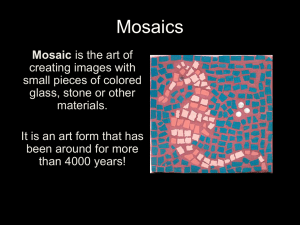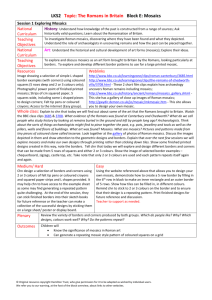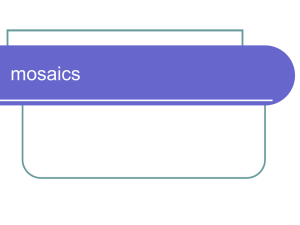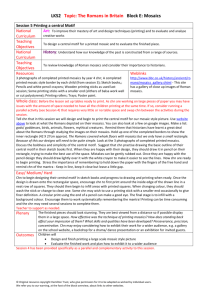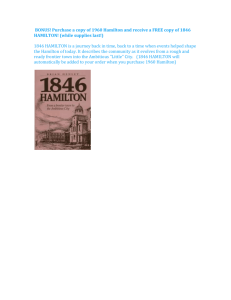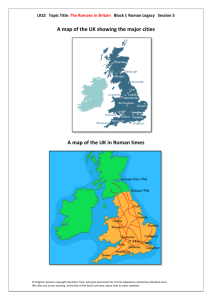Block Outcomes - Hamilton Trust
advertisement
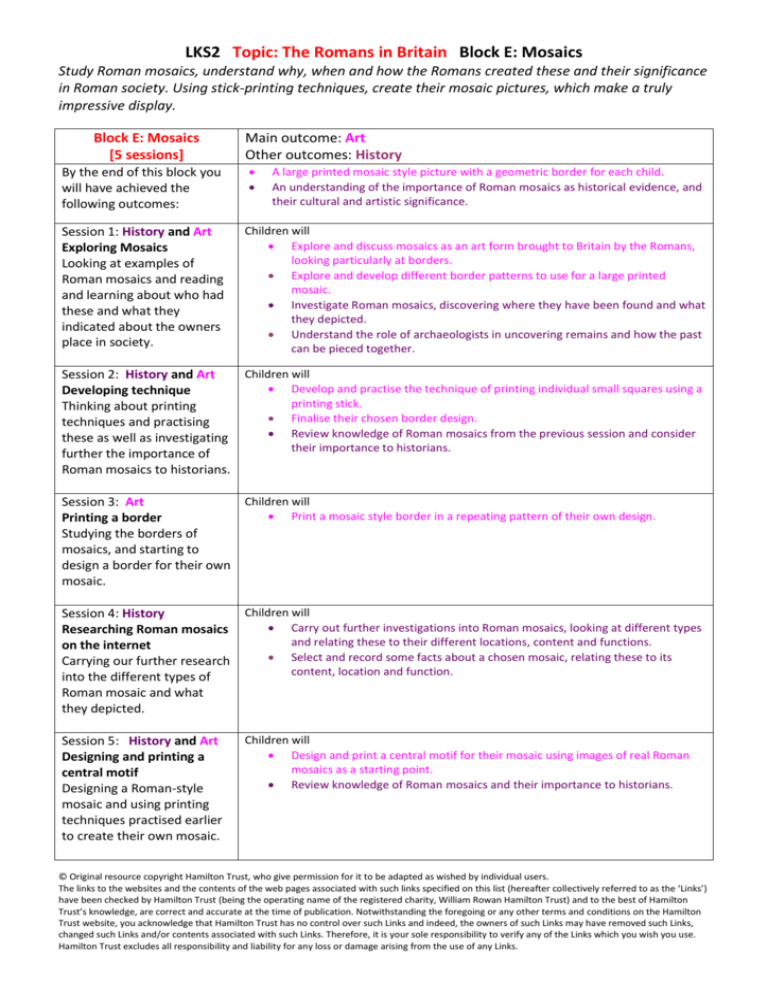
LKS2 Topic: The Romans in Britain Block E: Mosaics Study Roman mosaics, understand why, when and how the Romans created these and their significance in Roman society. Using stick-printing techniques, create their mosaic pictures, which make a truly impressive display. Block E: Mosaics [5 sessions] By the end of this block you will have achieved the following outcomes: Main outcome: Art Other outcomes: History A large printed mosaic style picture with a geometric border for each child. An understanding of the importance of Roman mosaics as historical evidence, and their cultural and artistic significance. Session 1: History and Art Exploring Mosaics Looking at examples of Roman mosaics and reading and learning about who had these and what they indicated about the owners place in society. Children will Explore and discuss mosaics as an art form brought to Britain by the Romans, looking particularly at borders. Explore and develop different border patterns to use for a large printed mosaic. Investigate Roman mosaics, discovering where they have been found and what they depicted. Understand the role of archaeologists in uncovering remains and how the past can be pieced together. Session 2: History and Art Developing technique Thinking about printing techniques and practising these as well as investigating further the importance of Roman mosaics to historians. Children will Develop and practise the technique of printing individual small squares using a printing stick. Finalise their chosen border design. Review knowledge of Roman mosaics from the previous session and consider their importance to historians. Children will Session 3: Art Print a mosaic style border in a repeating pattern of their own design. Printing a border Studying the borders of mosaics, and starting to design a border for their own mosaic. Session 4: History Researching Roman mosaics on the internet Carrying our further research into the different types of Roman mosaic and what they depicted. Children will Carry out further investigations into Roman mosaics, looking at different types and relating these to their different locations, content and functions. Select and record some facts about a chosen mosaic, relating these to its content, location and function. Session 5: History and Art Designing and printing a central motif Designing a Roman-style mosaic and using printing techniques practised earlier to create their own mosaic. Children will Design and print a central motif for their mosaic using images of real Roman mosaics as a starting point. Review knowledge of Roman mosaics and their importance to historians. © Original resource copyright Hamilton Trust, who give permission for it to be adapted as wished by individual users. The links to the websites and the contents of the web pages associated with such links specified on this list (hereafter collectively referred to as the ‘Links’) have been checked by Hamilton Trust (being the operating name of the registered charity, William Rowan Hamilton Trust) and to the best of Hamilton Trust’s knowledge, are correct and accurate at the time of publication. Notwithstanding the foregoing or any other terms and conditions on the Hamilton Trust website, you acknowledge that Hamilton Trust has no control over such Links and indeed, the owners of such Links may have removed such Links, changed such Links and/or contents associated with such Links. Therefore, it is your sole responsibility to verify any of the Links which you wish you use. Hamilton Trust excludes all responsibility and liability for any loss or damage arising from the use of any Links. LKS2 Topic: The Romans in Britain Block E: Mosaics Resources Session 1 Provided: Image showing a selection of simple L shaped border examples (with corners) using coloured squares (5 rows deep and 2 or 3 colours only); You will need: Photographs/ power point of finished printed mosaics; Strips of cm squared paper, 5 squares wide, including some L shaped pieces to design corners; Felt tip pens or coloured crayons; Access to the internet (Easy group). Session 2 Provided: 3 images of Roman mosaics depicting scenes. You will need: Wooden printing sticks (at least enough for one per child) made from 1cm x 1cm spar cut into approx. 7cm lengths (sandpaper the ends to make them flat and smooth); Strips of black or brown sugar paper 9cm wide and at least 30cm long; Printing rollers; Trays; Poster paint; A selection of the finished border designs from last session. Session 3 Provided: Visual access to the border-practice strips printed in session 2 (either on display or available). You will need: Several photographs of completed printed mosaics by year 4 chn (from previous years); Wooden printing sticks as used last session; Some printing sticks with a smaller end (slithers of balsa work well or cut polystyrene); Printing rollers; Trays; Poster paint; White pencil crayons; Some card border templates 60cm X 9cm; A large sheet of sugar paper per child (60cm X 45cm); Dark colours like black or brown work really well as the gaps between the printed tiles look like mortar. Session 4 Provided: Task Sheet (A prompt sheet that outlines the task and gives suggested websites and questions to think about. You will need: Access to computers and reference books (or some photocopied pages and printouts of good images and information). Session 5 Provided: You will need: 3 photographs of completed printed mosaics by year 4 chn; A completed printed mosaic style border by each child (from session 3); Sketch books,; Pencils and white pencil crayons; Wooden printing sticks as used last session; Some printing sticks with a smaller end (slithers of balsa work well or cut polystyrene); Printing rollers; Trays; Poster paint. © Original resource copyright Hamilton Trust, who give permission for it to be adapted as wished by individual users. The links to the websites and the contents of the web pages associated with such links specified on this list (hereafter collectively referred to as the ‘Links’) have been checked by Hamilton Trust (being the operating name of the registered charity, William Rowan Hamilton Trust) and to the best of Hamilton Trust’s knowledge, are correct and accurate at the time of publication. Notwithstanding the foregoing or any other terms and conditions on the Hamilton Trust website, you acknowledge that Hamilton Trust has no control over such Links and indeed, the owners of such Links may have removed such Links, changed such Links and/or contents associated with such Links. Therefore, it is your sole responsibility to verify any of the Links which you wish you use. Hamilton Trust excludes all responsibility and liability for any loss or damage arising from the use of any Links.

